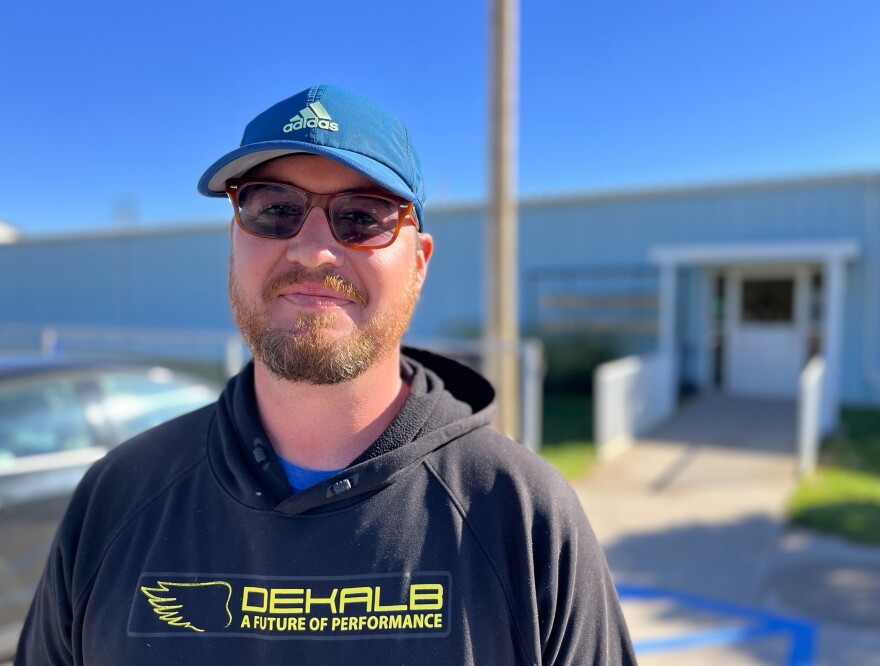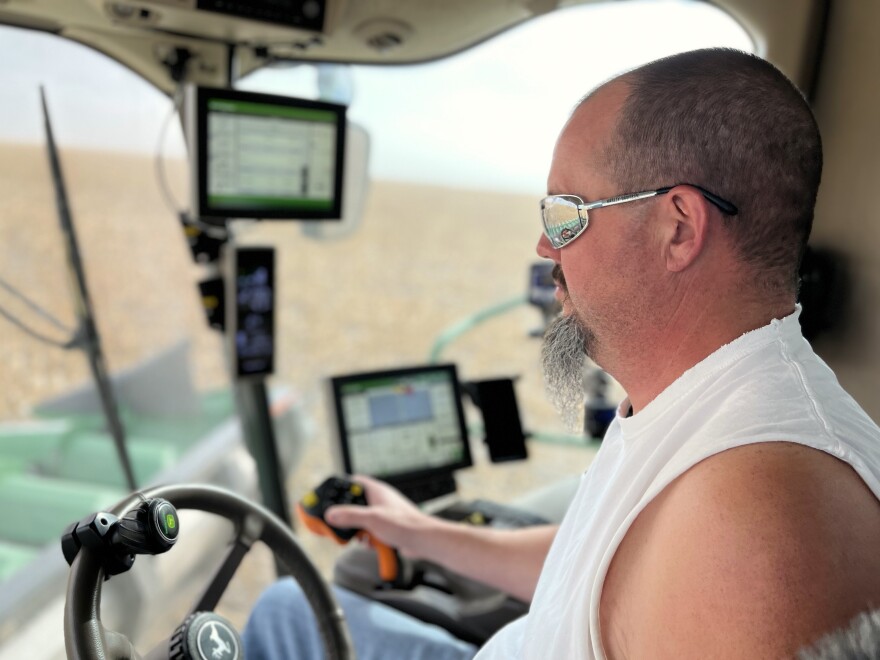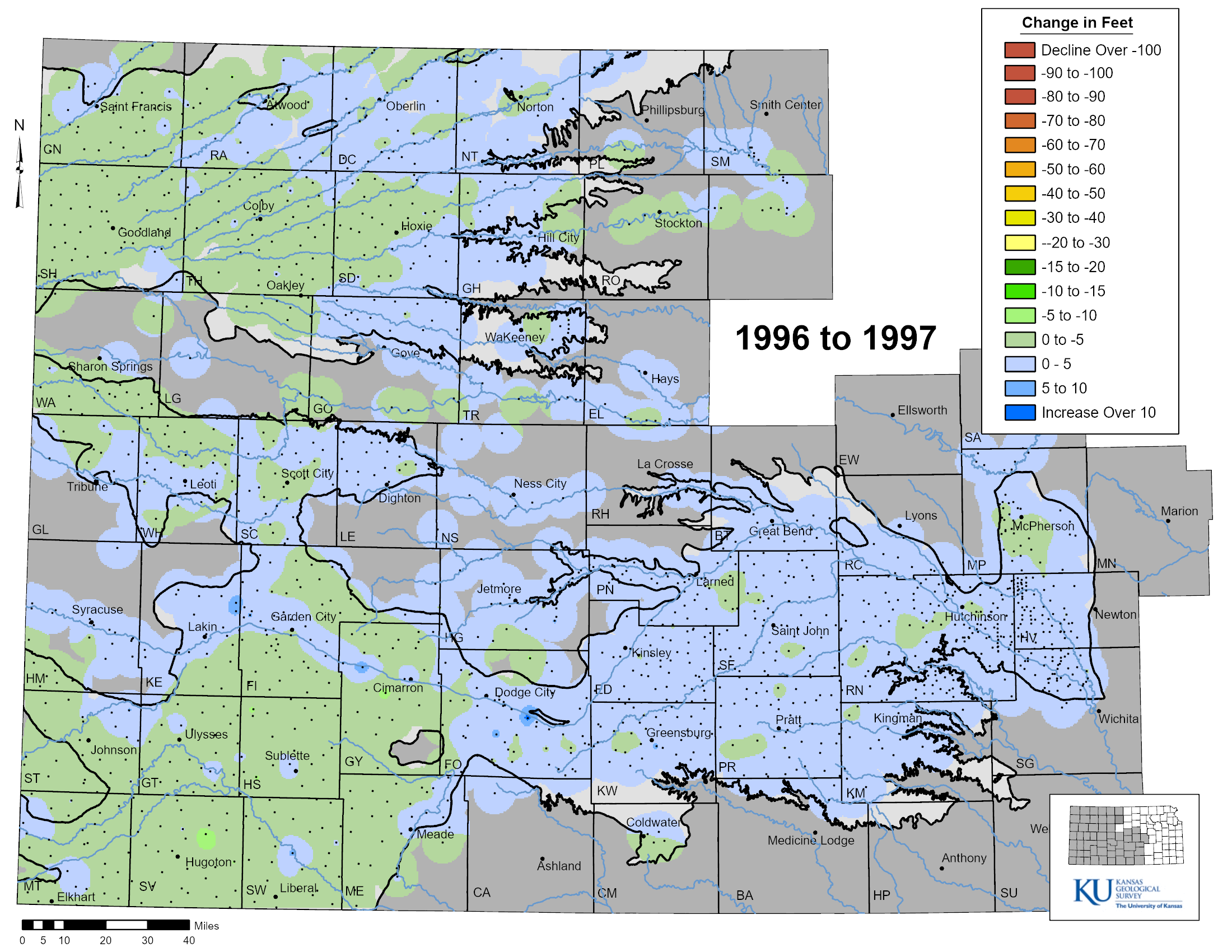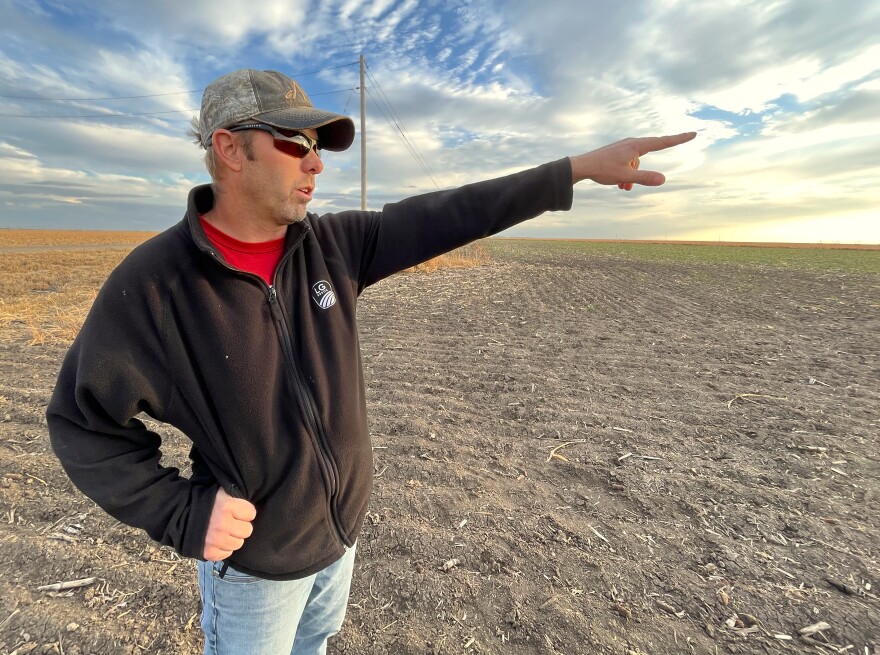SUBLETTE, Kansas — Travis Leonard had seen all the signs.
Plummeting water levels. Clogged sprayer nozzles. Then as drought parched southwest Kansas this fall, the well next to his farmhouse in Haskell County began pumping up a muck of sand instead of clear water.
After more than six decades of irrigating the family's grain field, he shut the well down for the last time.
“I just took a deep breath,” Leonard said, “knowing this is the last crop that I’m going to have here that has water on it.”

Leonard remembers when the underground water supply seemed endless. When he took over the farm 16 years ago, it had more than a dozen irrigation wells pumping. Today, it’s down to three.
A decade or two from now, he figures, his area won’t have any irrigation wells left.
“We didn’t have any idea when it was going to end, but that day is coming,” Leonard said. “It will happen to everybody eventually.”

Fly over these dry plains and you won’t see many rushing rivers or glimmering lakes. You’ll see circles. Mile after mile of green geometric crop fields spun into the near-desert landscape by wells that tap water hidden beneath the surface and the center pivot irrigation sprayers splayed around them.
But across western Kansas, more and more wells sit abandoned as underground water levels drop and drop some more. Vast swaths of the region have seen more than half of their water disappear since the dawn of irrigation. Wallace County on the Colorado border has lost roughly 80%.
The subterranean reservoirs of the sprawling Ogallala Aquifer make life possible here — from powering the multibillion-dollar agricultural economy to filling up cups at the kitchen sink.
But after decades of large-scale crop irrigation, that water is running out. And now farmers and state leaders struggle to agree on how to save the future of life in western Kansas without choking the livelihoods of the people who live here.

- Here's how this year's drought has battered the Midwest — and what it might mean for next year
- Farmers trying to save the Ogallala aquifer face tension from peers, but their profits are improving
- A hotter, drier climate and dwindling water has more Kansas farmers taking a chance on cotton
- This is the first time the Kansas Water Authority has voted to save what's left of the Ogallala
- This city in Kansas really conserves its water, but that still might not be enough to survive
- Western Kansas wheat crops are failing just when the world needs them most
- Up to 1 million birds count on Kansas wetlands during migration. Drought has left them high and dry
- As fertilizer pollutes tap water in small towns, rural Kansans pay the price
- How Kansas could lose billions in land values as its underground water runs dry
The good news? There’s still time. After all, an aquifer that’s half-empty is also half-full.
Even with all the depletion, billions and billions of gallons remain stored away in the Ogallala’s craggy layers of saturated rock. And a new effort in west-central Kansas aims to save more of what’s left.
Katie Durham, who leads that groundwater management district, said it’s not too late to preserve the aquifer — and the western Kansas farms, businesses and communities that depend on it — for future generations.
But only if big changes start now.
“This is do or die,” Durham said. “Water is everything out here. … We would not be here without it.”
Now or never
In a wood-paneled room at the Scott County fairgrounds, dozens of farmers gather for the first public hearing to discuss this latest effort in west-central Kansas. It’s called a local enhanced management area, or LEMA, and it’s been nearly a decade in the making.
The plan is to get farmers to cut irrigation by an average of 10% over the next five years in four western Kansas counties — Wallace, Greeley, Scott and Lane. Those counties have been some of the hardest hit by aquifer declines, losing nearly two-thirds of their water since irrigation began.
And the flow of moisture that’s trickling back down to refill the aquifer is a drop in the bucket. Across the four counties, the amount of water pumped up is nearly 10 times the amount that seeps back underground from rain and snow.

Any change is hard, Durham said, and discussions about using less water in a place with so little precipitation are bound to be prickly. But she said the alternative — a depleted aquifer that can’t support any irrigation — would essentially end life in western Kansas as we know it.
Residents and businesses leaving town. Empty storefronts on Main Street.
“It would be devastating,” Durham said. “You would see the exact thing that we're trying to prevent.”
The LEMA plan would customize each farmer’s water limits on a case-by-case basis. Those who have been pumping the most would need to cut irrigation by up to 25%. Others who have been voluntarily conserving the most water already might not need to make any changes.

Data from the Kansas Geological Survey shows that the four counties would need to reduce pumping by one-third to stop the aquifer’s depletion over the next decade. In drought conditions like we’re seeing now, they would need to cut pumping by half.
So trimming irrigation by 10% isn’t going to solve the problem permanently. But, Durham said, it’s a start. If this plan can double the aquifer’s lifespan, that could mean it’s still around for the grandchildren of the people who make those changes today.
“This is a huge and significant step,” Durham said, “toward changing what this part of western Kansas could look like in 50 years.”
If the state approves the plan after its second public hearing in early February, it would likely go into effect from the beginning of this year through 2027. Farmers would be able to use their five-year water allotment as they wish, meaning they could pump extra during a dry year as long as they irrigate less in a subsequent year to even things out.

The key to this LEMA program is putting water conservation decisions in the hands of a local board, rather than the state. But that doesn’t mean it’s all kumbaya.
Water has long been a point of contention in dry western Kansas. That’s because water means money. Even as wells run out, pumping the aquifer continues to prop up the regional economy — from corn and wheat growers to irrigation equipment dealers to cattle feedlots.
The groundwater district proposing the new LEMA is the smallest in western Kansas, but it still covers more than one million acres and nearly 2,000 wells. With that many voices in the discussion, it can be a challenge to get everyone on board.
Many irrigators remain wary of any program that might force them to use less water.

Lane County farmer Camron Shay came to the hearing with his own concerns about how the limits could be fair for everyone across a region that has so much diversity in how much water has been used, how much water is needed to nurture a crop and how much water is left.
“It can’t just be done by a bunch of activists,” Shay said, “who come in and don’t know what they’re talking about and strong arm it and do radical things.”
But the locally driven approach of the LEMA may help ease those fears. That was the point of the public hearing and the series of community meetings that came before. After getting some of his questions answered, Shay said, he walked away feeling better about the plan.
“We all know that we have a groundwater problem,” he said. “I don’t know if there’s a good solution for it, but these guys look like they’re at least trying.”

Proof of concept
Fortunately, farmers in the four counties don’t have to look far to find examples of how these irrigation limits work in the real world.
The state’s first LEMA began in a small portion of northwest Kansas a decade ago. The plan was to reduce irrigation by 20%. When the results came in, farmers ended up cutting pumping by nearly one-third. And some of those farmers actually saw profits go up as they spent less to pump water and buy seed and fertilizer.
That initial LEMA was deemed so successful that a similar plan to cover parts of 10 northwest Kansas counties went into effect five years ago — although that expansion faced a lawsuit from dozens of irrigators who said it infringed on their water rights — and was recently renewed for another five years.
And right next to where the new limits are proposed, Wichita County started its own LEMA two years ago to cut irrigation by 25%.
That’s where Brian Bauck sat in a combine harvesting his last cornfield of the year.

Most of his fields are now non-irrigated, or dryland, and the sections that see a center pivot get less water than they did decades ago. So the past year of drought has left its mark.
As he makes one last pass with his combine, its wide green header has to skim the ground to reach the rows of short corn plants out the front window. It scoops up its fair share of dry tumbleweeds that have blown in with the punishing winds, too.
But thanks to new drought-tolerant seed varieties and farming practices that conserve soil and moisture, he had crops to harvest on just about every acre this season.
“It feels great,” Bauck said. “Anytime you can get something, even though it may not be what you wanted, tells you that you’re probably doing a few things right.”

So far, Wichita County’s irrigation restrictions appear to be making a dent in depletion. Countywide aquifer declines averaged 0.54 feet per year from 2010-2017, according to Kansas Geological Survey data. But from 2018-2021, the county only lost an average of 0.09 feet per year. As the programs produce more real-world data, it might reassure crop growers in neighboring areas that irrigation reductions are worth a shot.
Farmers are naturally independent thinkers, Bauck said, so it's always a challenge when somebody comes in and tries to tell them how to do their jobs. He used to be skeptical about irrigation cuts too.
And changing farmers’ mindsets about water use isn’t a simple task because their livelihoods are at stake. In a dry year like this, turning the sprayer on could make the difference between growing some crops or none at all.
But, he said, the golden kernels filling his grain tank prove that farming with less irrigation can work in western Kansas, even in a historically dry season.
It shows that a future with less water may not be painless, but it is possible. And in western Kansas, he said, it’s a matter of survival.
“Regardless of whether somebody likes it or not,” Bauck said, “we’ve got to do something in order to extend the life of this aquifer, or it’s not gonna be there.”

Gallons and dollars
Another reason for urgency? Climate change. As the H2O buffet dwindles down, Kansas heats up.
With dry western weather shifting eastward, more of the state will likely face a future with worse droughts and less precipitation — a process called aridification.
Vaishali Sharda, assistant professor of biological and agricultural engineering at Kansas State University, studies how a drier, hotter future threatens the state’s farms. Aridification paired with a declining aquifer, she said, sets up a potential time bomb for western Kansas agriculture.
“There is no guessing,” Sharda said. “If we continue irrigating at the pace at which we have done in the past, the Ogallala won’t be able to sustain it.”

Even if irrigators could save a relatively small percentage of the water they’ve been using, the impact could be enormous — simply because of how many gallons we’re talking about.
In the four counties with the proposed LEMA, for instance, 94% of all water used goes to irrigate crops.
Statewide, roughly three-fourths of all water used in Kansas comes from the High Plains aquifer, and nearly all of that goes to irrigation. Over the course of a year, that averages out to 2.5 billion gallons of groundwater used to water crops each day.
But finding consensus on new rules to curb aquifer use is an uphill climb when using that water is the foundation that virtually everything else in western Kansas is built on.
Take southwest Kansas. It has — and uses — the biggest chunk of the state’s aquifer. And its agriculture relies more on irrigation than anywhere else in Kansas. Cattle feedlots, meatpacking plants and dairy farms all depend on the corn feed that’s grown here.

But when some farmers proposed a LEMA for parts of Kearny County and Finney County a few years ago, the region’s groundwater management district shot it down.
District director Mark Rude expects conversations about irrigation limits — maybe even a new LEMA — to start back up in his district over the next few years. And the district recently began sending its irrigators detailed reports about their water use and comparing it to their neighbors in an attempt to get farmers to change their mindsets.
But even with more information about depletion and conservation than ever, he still believes his members aren’t ready for widespread irrigation cuts. Strict rules to save the aquifer don’t make sense, he said, if they come at the expense of the economy.
“To get growth,” Rude said, “you’ve got to have water.”

He’s exploring a plan to bring in water from the Missouri River — potentially flowing across the state in an aqueduct hundreds of miles long — to replace what’s lost in the Ogallala.
While the district hasn’t figured out how to make that plan’s $18 billion price tag financially feasible, he said, it might be the only way to keep the region’s industries — from corn to cattle to ethanol — booming for future decades.
Converting western Kansas to dryland farming may be sustainable, he said, but it would mean a smaller economy with fewer jobs and fewer people in a region where most counties already struggle with population decline.
The real question, he said, is what kind of economic future does western Kansas want to sustain?
“It’s important that we not forget that what we’re trying to preserve here is not only the community as a whole,” Rude said, “but the business strategy, the overall viability of that community.”

But whether or not a groundwater district or state entity decides to impose irrigation limits, farmers across western Kansas are already adjusting to the realities of a life with less water — because they have to.
Many have adopted smarter irrigation technology, such as soil moisture sensors and systems that customize irrigation rates across a field. Some have switched to crops that require less water than corn, such as cotton.
Others have stopped irrigating entirely on a majority of their acres. That’s the case for Leonard, the farmer with the dry well whose land lies within the southwest Kansas groundwater district.
The thought of leaving irrigation behind, he said, doesn’t have to be scary. In a way, it’s coming full circle.
When his great-grandfather started the Leonard farm, there wasn’t an irrigation well or center pivot in sight. And by the time he retires, Leonard expects his entire farm will return to its dryland roots.
“Life will go on,” Leonard said. “We’re still running a farm here. And it looks a little bit different than it used to but we’re still doing what we love.”
David Condos covers western Kansas for High Plains Public Radio and the Kansas News Service. You can follow him on Twitter@davidcondos.
The Kansas News Service is a collaboration of KCUR, Kansas Public Radio, KMUW and High Plains Public Radio focused on health, the social determinants of health and their connection to public policy.
Kansas News Service stories and photos may be republished by news media at no cost with proper attribution and a link to ksnewsservice.org.







